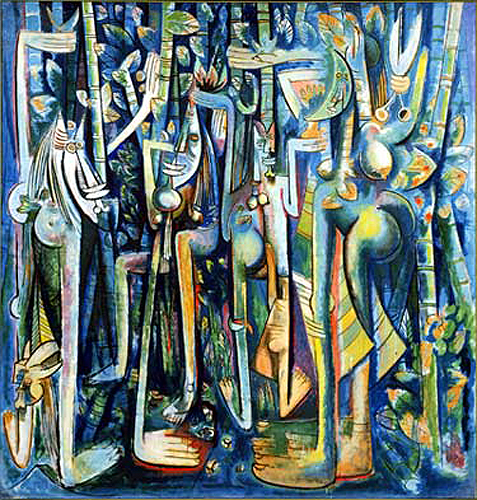Source: The National Museum of Cuba. Havana: Letras Cubanas, 1978, fig. 116. Photograph by WTL©.
Image: Wifredo Lam, "La Jungla / The Jungle" (1943-1944). Oil on canvas. This painting is in the Museum of Modern Art (MOMA) in New York City.
Comments: This painting is the one to which Alejo Carpentier (major twentieth-century writer and theorizer of so-called Magical Realism) refers as a key for seeing and understanding what lo real maravilloso (Magical Realism?) is. In this painting you see what art criticism calls polymorphism of humans, animals, and plants, the result of which is hybridism. In 1940, with Nazi Germany occupying Paris and northern France, Lam moved to Marseille on France's Mediterranean coast, where he continued working in the manner of Picasso and other modern artists. In 1941, Lam left France in the grip of World War II and returned to Cuba. However, Lam was not given a warm welcome in Cuba since Lam's European modernism (the avant-garde and surrealism) was partly alien to the vibrant and predominantly indigenous art and literature scene in Cuba.
Art critics have seen "La Jungla" (1944) as "the quintessential masterpiece" (Goizueta) of the decade of the 1940s. Recognizing the genius of this painting, Carpentier said this about it: "This monumental painting [...] constitutes a transcendental contribution to the new world of American painting. There is creation in function of the environment. Reality and the dream world become confused. Poetry and painting become one. There is an atmosphere of myths and of color, thoroughly original. There exists a world unto its own" (quoted by Goizueta, 16).
Note: In order to answer the following questions, first read: => "About the Latin American Real Maravilloso" by Alejo Carpentier.
Humanities Questions: (A) What do you see in this painting? (B) What is its style? (C) What is its content? (D) What African or Afro-Cuban elements do you see? (E) How do its style and content relate to each other, reinforce each other? (F) What does the title mean, and what does it refer to? (G) What does Carpentier's article contribute to your understanding of this painting? (H) What is the date of Carpentier's article? (I) In what way are we exposed to a true interdisciplinary humanities exercise in seeking interpretations, answers, and appreciation based on (a) Lam's painting, (b) the theory of the real maravilloso, (c) a twentieth-century essay, (d) Latin American historical reality, and (e) literature, art, film that arise from the above?

